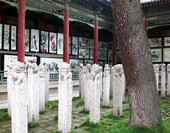
Forest of Stone Steles Museum Xian Guide
-Travel to Forest of Stone Steles Museum Xian Xi'an Forest of Stone Tablets was originally built in 1087. The Forest of Stone Steles in Xi'an holds a big collection of steles in China. It is a classical courtyard styled structure at the site of former Confucian Temple in Sanxue Street, Xian, close to the south gate of Xi'an City Wall. The museum has an area of over 30,000 square meters. It is one of the centers of ancient Chinese stone-engraving classic. It is also the center of the works of art of noted calligraphers of past dynasties. The numerous standing steles likes a forest, hence the name " Forest of Steles"'. With a history of over 900 years, it is an art treasure well known at home and abroad.
Xi'an Forest of Stone Tablets was originally built in 1087. The Forest of Stone Steles in Xi'an holds a big collection of steles in China. It is a classical courtyard styled structure at the site of former Confucian Temple in Sanxue Street, Xian, close to the south gate of Xi'an City Wall. The museum has an area of over 30,000 square meters. It is one of the centers of ancient Chinese stone-engraving classic. It is also the center of the works of art of noted calligraphers of past dynasties. The numerous standing steles likes a forest, hence the name " Forest of Steles"'. With a history of over 900 years, it is an art treasure well known at home and abroad.
 These pieces of art are works dating from the Han Dynasty through to the Qing Dynasty with over 1,000 memorial tablets forming the Forest of Stone Tablets. Xi'an Forest of Stone Tablets is more than a treasure house of ancient Chinese calligraphy. It is also a big collection of China's historical documents and records and stone carving patterns. These tablets keeps a record of some of the large achievements of Chinese culture. It can show us today the truth of the cultural intercourse among China and other countries. It is a shame that tourist will miss the Forest of Stone Tablets if they travel to Xian.
These pieces of art are works dating from the Han Dynasty through to the Qing Dynasty with over 1,000 memorial tablets forming the Forest of Stone Tablets. Xi'an Forest of Stone Tablets is more than a treasure house of ancient Chinese calligraphy. It is also a big collection of China's historical documents and records and stone carving patterns. These tablets keeps a record of some of the large achievements of Chinese culture. It can show us today the truth of the cultural intercourse among China and other countries. It is a shame that tourist will miss the Forest of Stone Tablets if they travel to Xian.
 The Xl'an Forest of Stone Tablets was born out of the place where the stone classics in the Tang Dynasty were kept. The so called stone classics during the Tang Dynasty included the "Classic of Filial Piety" in the handwriting of Emperor Xuan Zong in 745 A.D. and the "Kaicheng Stone Classics" engraved in 837 A. D. These stone classics were originally erected inside the Imperial Ancestral Temple (in the vicinity of Wenyi Road, southern suburbs, Xi'an) in the Tang Dynasty. By the end of the Tang Dynasty, Zhu Wen forced Tang Zhao Zong to move the capital to Luoyang and destroyed Chang'an City almost completely, bringing it down to ruins. Han Jian, commander-in-chief, reduced the size of the city for the purpose of easy defence. As a result, the stone classics were abandoned in the wild suburbs. Later on, Han Jian was the first to move the Imperial Ancestral Temple and the Classics of Filial Piety into Confucian Temple (along the Shehui Road, western street, Xi'an) inside the city prop .
The Xl'an Forest of Stone Tablets was born out of the place where the stone classics in the Tang Dynasty were kept. The so called stone classics during the Tang Dynasty included the "Classic of Filial Piety" in the handwriting of Emperor Xuan Zong in 745 A.D. and the "Kaicheng Stone Classics" engraved in 837 A. D. These stone classics were originally erected inside the Imperial Ancestral Temple (in the vicinity of Wenyi Road, southern suburbs, Xi'an) in the Tang Dynasty. By the end of the Tang Dynasty, Zhu Wen forced Tang Zhao Zong to move the capital to Luoyang and destroyed Chang'an City almost completely, bringing it down to ruins. Han Jian, commander-in-chief, reduced the size of the city for the purpose of easy defence. As a result, the stone classics were abandoned in the wild suburbs. Later on, Han Jian was the first to move the Imperial Ancestral Temple and the Classics of Filial Piety into Confucian Temple (along the Shehui Road, western street, Xi'an) inside the city prop .
More Attractions in Xian
- The Big Wild Goose Pagoda
- The Ancient City Wall
- Tang Dynasty Dance and Music
- Tomb of Emperor QinShiHuang
- Imperial Dumpling Banquet
- Terra-Cotta Warriors
- Mt. Hua
- The Great Mosque
- the Bell Tower
- Huaqing Hot Springs
- Shanxi Provincial History Museum
- The Drum Tower
- Xian Famen Temple
- Xian Banpo Museum
- Qianling Mausoleum
- Xi’an Muslim Street
- Forest of Stone Steles Museum Xian
- Site of Daming Palace
Your Question & Quick Answer*We welcome and appreciate your questions & reviews
Booking Procedures | Terms & Conditions | Payment Methods | Links | Site Map | About Us | Contact Us | Travel Agent
Copyright 2008, All rights reserved.. itourbeijing.com professional china travel guide and china travel service
TEL: 86-10-85711972 (Universal) 1-888-288-9328 (North America) E-mail: contact@itourbeijng.com
Tours Index | China Tours | Beijing Tours | Xi'an Tours | Shanghai Tours | Guilin Tours | Tibet Tours
China Travel | Beijing Travel | Shanghai Travel | Xi'an Travel | Guilin Travel |Beijing Map
China Golf | Beijing Golf | Shanghai Golf | Xiamen Golf | The Great Wall Travel | Yangtze Cruise | Travel Picture



